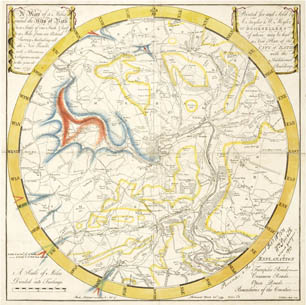Geological Map of Bath, 1799

|
|
 |
Map of Bath, 1799 (LDGSL/739)
|
|
2014 Reconstruction (LDGSL/742a) |
| Click to enlarge |
|
This document on the left, created in 1799, is considered to be one of the earliest geological maps ever created. Drawn on the base map 'A Map of Five Miles round the City of Bath, on a scale of one inch and a half to a mile, from an Actual Survey, including all the new roads, with Alterations and Improvements to the present time…’ (1799), it demonstrates an early use of William Smith’s ‘fading’ colouring technique which emphasised the outcrops of each stratum. Smith explained his reasoning for adopting this method:
|
“I drew in colours, on a map of the vicinity of Bath…all [that had been observed] very accurately to a certain extent, which embraced an interesting but intricate variety of strata in hills around Bath; and some small maps of England were spoiled by speculating on the ranges of stratification without sufficient data. The intricacies in their marginal edges were such that I found, to mark point by point, as the facts were ascertained, was the only way in which I could safely proceed.” [from Phillips, J, ‘Memoirs of William Smith, LLD’, (1844) p27]
|

|
|
|
Like Smith’s ‘Table of Strata in the Vicinity of Bath’, it was gifted to the Society in 1831, varnished then hung on the wall for many years resulting in it being rather faded and discoloured. Next to it, therefore, is a reconstruction of what it may have looked like when first created.
Smith provides no key, but the yellow tint represents the Bath Oolite, the blue marks the base of the Lias and the red the base of the Trias.
|
<<Stratigraphical theories
Typical fossils in the Kelloways Stone stratum>>